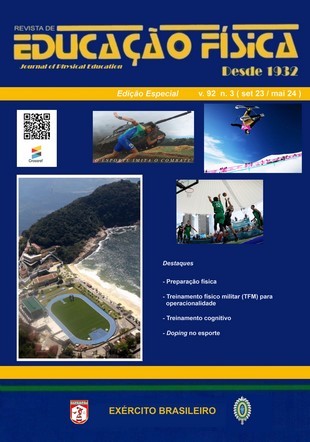Abstract
Introduction: High performance sports demand maximum performance from athletes and, in this context, there is a search by athletes for supplementary resources of substances that promote the increase of an already high performance. The issue is of great interest to athletes, coaches, and health professionals that work with high-performance athletes.
Objective: The objective of the present study was to highlight the importance of medical-scientific research on the use of substances that contribute to the increase in physical performance in the relationship between health benefits and risks in the context of sport and exercise.
Conclusion: The importance of medical-scientific research on the use of substances and methods that contribute to the increase in physical performance in the relationship between health benefits and risks in the context of sport and exercise dates to the beginnings of the practice of physical exercise, in the Ancient Age. Nowadays, it is a fundamental subject in the field of high-performance sports. Current issues were presented and discussed.
References
Holt RIG, Erotokritou-Mulligan I, Sönksen PH. The history of doping and growth hormone abuse in sport. Growth hormone & IGF research: official journal of the Growth Hormone Research Society and the International IGF Research Society. 2009;19(4): 320–326. https://doi.org/10.1016/j.ghir.2009.04.009.
Dictionary Cambridge. Fair play. Dictionary Cambridge. https://dictionary.cambridge.org/dictionary/english-portuguese/fair-play [Accessed 10th April 2024].
Wei M, Wang J. Potential health risks of foodborne performance-enhancing drugs in competitive sports. Heliyon. 2023;9(10): e21104. https://doi.org/10.1016/j.heliyon.2023.e21104.
Lusetti M, Licata M, Silingardi E, Bonsignore A, Palmiere C. Appearance/Image- and Performance-Enhancing Drug Users: A Forensic Approach. The American Journal of Forensic Medicine and Pathology. 2018;39(4): 325. https://doi.org/10.1097/PAF.0000000000000424.
Castanho GKF, Fontes EB, Fernandes PT. O perigo da contaminação de suplementos alimentares com substâncias ilícitas para os praticantes de exercício físico e esporte. Conexões. 2014;12(1): 161–180. https://doi.org/10.20396/conex.v12i1.2186.
Kremenik MJ, Onodera S, Nagao M, Yuzuki O, Yonetani S. A Historical Timeline of Doping in the Olympics (Part 1 1896-1968). Kawasaki journal of medical welfare. 2006; https://www.semanticscholar.org/paper/A-Historical-Timeline-of-Doping-in-the-Olympics-1-Kremenik-Onodera/b5d37329984a5cd2a794c0cb53b419812c1b4640
World Anti-Doping Agency. Who We Are. World Anti Doping Agency. https://www.wada-ama.org/en/who-we-are [Accessed 11th April 2024].
Fèdèration Internationale de Mèdicine du Sport A. Statement on Doping in Sport. 1993. fims.org/files/4414/2056/2561/PS13-Statement-on-Doping-in-Sport.pdf [Accessed 10th April 2024].
Fèdèration Internationale de Mèdicine du Sport. Doping nos esportes. Revista Brasileira de Medicina do Esporte. 1998;4: 28–28. https://doi.org/10.1590/S1517-86921998000100008.
World Anti-Doping Agency. The Prohibited List. World Anti Doping Agency. https://www.wada-ama.org/en/prohibited-list [Accessed 11th April 2024].
Backhouse SH. A Behaviourally Informed Approach to Reducing the Risk of Inadvertent Anti-doping Rule Violations from Supplement Use. Sports Medicine (Auckland, N.Z.). 2023;53(Suppl 1): 67–84. https://doi.org/10.1007/s40279-023-01933-x.
De Rose EH, Feder MG, Pedroso PR, Guimarães AZ. Referred use of medication and dietary supplements in athletes selected for doping control in the South-American Games. Revista Brasileira de Medicina do Esporte. 2006;12: 239–242. https://doi.org/10.1590/S1517-86922006000500003.
Kozhuharov VR, Ivanov K, Ivanova S. Dietary Supplements as Source of Unintentional Doping. BioMed Research International. 2022;2022: 8387271. https://doi.org/10.1155/2022/8387271.
Lauritzen F, Gjelstad A. Trends in dietary supplement use among athletes selected for doping controls. Frontiers in Nutrition. 2023;10: 1143187. https://doi.org/10.3389/fnut.2023.1143187.
Segatti JCM, Oliveira DV de, Antunes MD, Leme DE da C, Jacob W. Substâncias farmacológicas e o doping esportivo. Biológicas & Saúde. 2016;6(22). https://doi.org/10.25242/886862220161049.
Bialowas D, Laskowski R, Franchini E, Kujach S. Examining the effects of pre-competition rapid weight loss on hydration status and competition performance in elite judo athletes. Scientific Reports. 2023;13(1): 14756. https://doi.org/10.1038/s41598-023-41872-1.
Heuberger JAAC, Cohen AF. Review of WADA Prohibited Substances: Limited Evidence for Performance-Enhancing Effects. Sports Medicine (Auckland, N.Z.). 2019;49(4): 525–539. https://doi.org/10.1007/s40279-018-1014-1.
World Anti-Doping Agency - WADA. International Olympic Committee. https://olympics.com/ioc/wada [Accessed 11th April 2024].
Kindermann W, Meyer T. Inhaled β2 agonists and performance in competitive athletes. British Journal of Sports Medicine. 2006;40(Suppl 1): i43–i47. https://doi.org/10.1136/bjsm.2006.027748.
Riiser A, Stensrud T, Stang J, Andersen LB. Aerobic performance among healthy (non-asthmatic) adults using beta2-agonists: a systematic review and meta-analysis of randomised controlled trials. British Journal of Sports Medicine. 2021;55(17): 975–983. https://doi.org/10.1136/bjsports-2019-100984.
Purnama SK, Doewes RI, Elumalai G, Azmi SH, Nuryadin I, Manshuralhudlori. Biosensor development in sports doping with dexamethasone. Revista Brasileira de Medicina do Esporte. 2023;29: e2022_0416. https://doi.org/10.1590/1517-8692202329012022_0416.
Dvorak J, Feddermann N, Grimm K. Glucocorticosteroids in football: use and misuse. British Journal of Sports Medicine. 2006;40(Suppl 1): i48–i54. https://doi.org/10.1136/bjsm.2006.027599.
Juszczak A, Morris D, Grossman A. Cushing’s Syndrome. In: Feingold KR, Anawalt B, Blackman MR, Boyce A, Chrousos G, Corpas E, et al. (eds.) Endotext. South Dartmouth (MA): MDText.com, Inc.; 2000. http://www.ncbi.nlm.nih.gov/books/NBK279088/ [Accessed 12th April 2024].
Henderson LP, Penatti C a. A, Jones BL, Yang P, Clark AS. Anabolic androgenic steroids and forebrain GABAergic transmission. Neuroscience. 2006;138(3): 793–799. https://doi.org/10.1016/j.neuroscience.2005.08.039.
Wenbo Z, Yan Z. The Uses of Anabolic Androgenic Steroids Among Athletes; Its Positive and Negative Aspects- A Literature Review. Journal of Multidisciplinary Healthcare. 2023;16: 4293–4305. https://doi.org/10.2147/JMDH.S439384.
Allen MJ, Sabir S, Sharma S. GABA Receptor. In: StatPearls. Treasure Island (FL): StatPearls Publishing; 2024. http://www.ncbi.nlm.nih.gov/books/NBK526124/ [Accessed 15th April 2024].
Watson CJ, Stone GL, Overbeek DL, Chiba T, Burns MM. Performance-enhancing drugs and the Olympics. Journal of Internal Medicine. 2022;291(2): 181–196. https://doi.org/10.1111/joim.13431.
Sander JD, Joung JK. CRISPR-Cas systems for editing, regulating and targeting genomes. Nature Biotechnology. 2014;32(4): 347–355. https://doi.org/10.1038/nbt.2842.
Cantelmo RA, da Silva AP, Mendes-Junior CT, Dorta DJ. Gene doping: Present and future. European Journal of Sport Science. 2020;20(8): 1093–1101. https://doi.org/10.1080/17461391.2019.1695952.
Dragčević D, Pandžić Jakšić V, Jakšić O. Athlete biological passport: longitudinal biomarkers and statistics in the fight against doping. Arhiv Za Higijenu Rada I Toksikologiju. 2024;75(1): 24–31. https://doi.org/10.2478/aiht-2024-75-3793.
Reardon CL, Creado S. Drug abuse in athletes. Substance Abuse and Rehabilitation. 2014;5: 95–105. https://doi.org/10.2147/SAR.S53784.
Tidmas V, Halsted C, Cohen M, Bottoms L. The Participation of Trans Women in Competitive Fencing and Implications on Fairness: A Physiological Perspective Narrative Review. Sports (Basel, Switzerland). 2023;11(7): 133. https://doi.org/10.3390/sports11070133.
International Olympic Committee. Olympic Modern Pentathlon. https://olympics.com/en/paris-2024/sports/modern-pentathlon. https://olympics.com/en/paris-2024/sports/modern-pentathlon [Accessed 15th April 2024]

This work is licensed under a Creative Commons Attribution 4.0 International License.
Copyright (c) 2024 Journal of Physical Education
